Whirlpool AWM 6125/P, AWM 6105/P, AWM 6085/P INSTRUCTION FOR USE
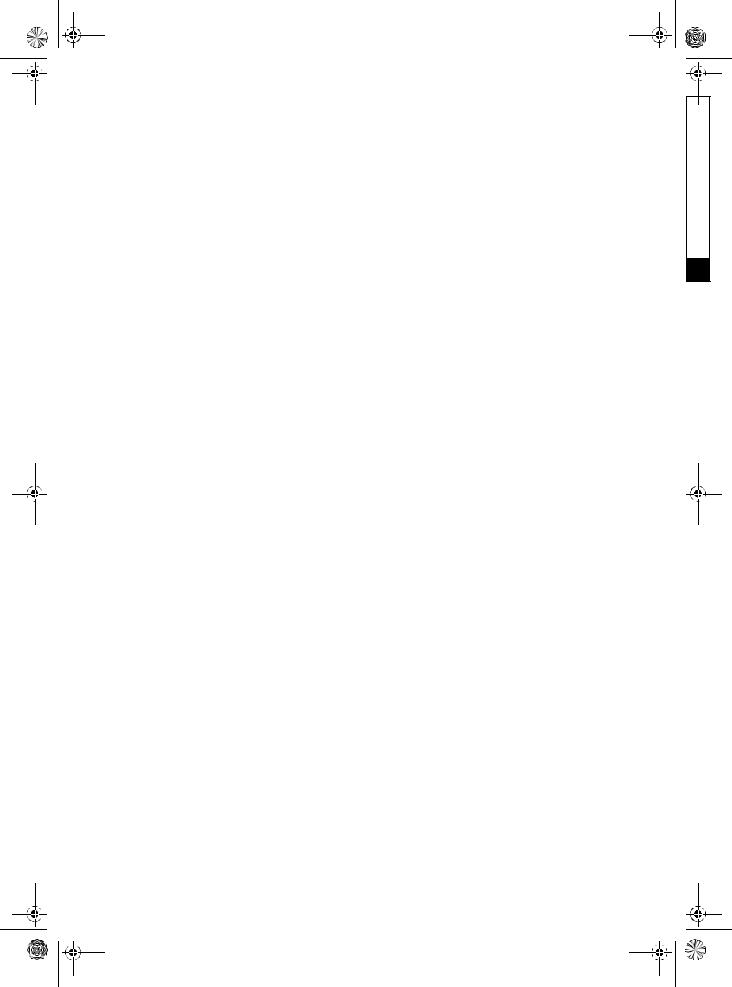
30110237GB.fm Page 19 Thursday, July 20, 2006 6:27 PM
CONTENTS
BEFORE USING THE WASHING MACHINE
PRECAUTIONS AND GENERAL
RECOMMENDATIONS
DESCRIPTION OF THE WASHING MACHINE DOOR
CHILD SAFETY (IF AVAILABLE)
BEFORE THE FIRST WASH CYCLE
PREPARING THE WASH
DETERGENTS AND ADDITIVES
REMOVING THE FILTER
DRAINING RESIDUAL WATER
CARE AND MAINTENANCE
TROUBLESHOOTING GUIDE
AFTER-SALES SERVICE
ACCESSORIES
TRANSPORT/HANDLING
INSTALLATION
ELECTRICAL CONNECTION
19
Black process 45.0° 100.0 LPI
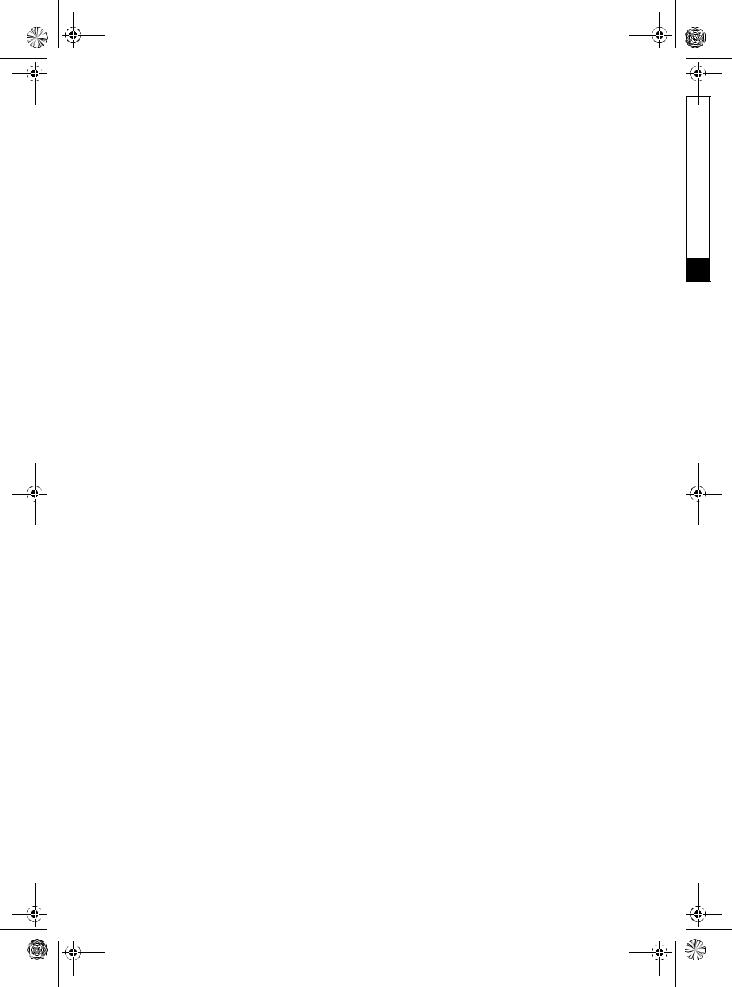
30110237GB.fm Page 20 Thursday, July 20, 2006 6:27 PM
BEFORE USING THE WASHING MACHINE
1.Remove the packaging and check
•After unpacking, make sure that the washing machine is undamaged. If in doubt, do not use the washing machine. Contact After-Sales Service or your local retailer
•Check that the accessories and supplied parts are all present
•Keep the packing material (plastic bags, polystyrene parts, etc.) out of reach of children, as they are potentially dangerous
2.Remove the transport bolts
•The washing machine is fitted with a transport bolts to avoid any possible damage to the interior during transport. Before using the washing machine, it is imperative that the transport bolts are removed
3.Install the washing machine
•Remove the protective foil from the control panel
•Move the appliance without lifting it by the worktop
•Install the appliance on a solid and level floor surface, preferably in a corner of the room
•Make sure that all four feet are resting firmly on the floor and check that the appliance is perfectly level (use a spirit level)
4.Water inlet
•Connect the water supply inlet hose in accordance with regulations of your local water company
• Water inlet: |
Cold water only |
• Tap: |
3/4” threaded hose connection |
•Water Pressure
(flow pressure): 100-1000 kPa (1-10 bar).
5.Drain hose
•Connect the drain hose to the siphon or hook it over the edge of a sink by means of the “U” bend supplied
•If the washing machine is connected to a built-in pumping out system, ensure that the latter is equipped with a vent to avoid simultaneous loading and draining of water (siphoning effect)
6.Electrical connections
•Electrical connections must be carried out by a qualified technician in compliance with the manufacturer’s instructions and local safety regulations
•Data concerning voltage, consumption and fuses are located on the inside of the appliance door
•The appliance must be connected to the mains exclusively by means of a socket with an earth connection in accordance with established regulations. The washing machine must be earthed by law. The manufacturer declines all liability for damage to property or injury to persons or animals due to non-compliance with the directions given above
•Do not use extension leads or multi sockets
•Before any maintenance on the washing machine disconnect it from the mains supply
•Access to the mains plug or to disconnection from mains supply via a double-pole switch must be ensured at all times following the installation
•Do not operate the washing machine if it has been damaged during transport. Inform the After-Sales Service
•Mains cable replacement is only to be carried out by After-Sales Service
•The washing machine must only be used in the household for the prescribed uses
Minimum housing dimensions:
Width: 600 mm
Height: 825 mm
Depth: 600 mm
20
Black process 45.0° 100.0 LPI
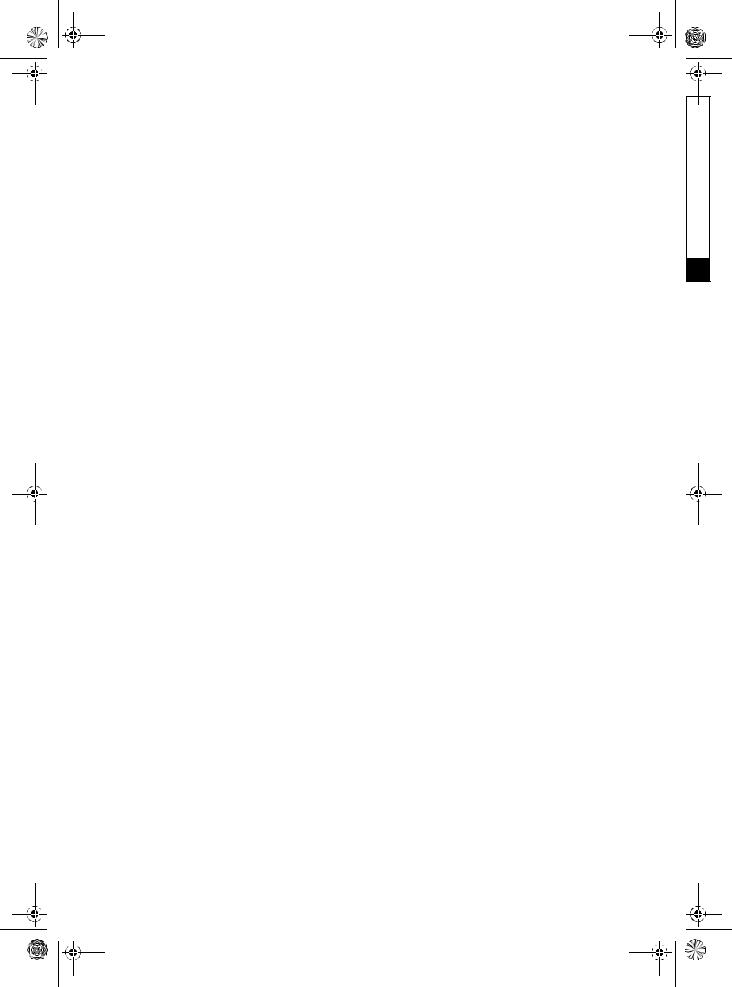
30110237GB.fm Page 21 Thursday, July 20, 2006 6:27 PM
PRECAUTIONS AND GENERAL RECOMMENDATIONS
1.Packaging
•The packaging is 100% recyclable and is marked
with the  recycling symbol. Adhere to current local regulations when disposing of packaging material
recycling symbol. Adhere to current local regulations when disposing of packaging material
2.Disposing of packaging and old washing machines
•The washing machine is built from reusable materials. It must be disposed of in compliance with current local waste disposal regulations
•Before scrapping, remove all detergent residues and cut off the power cable so that the washing machine is made unusable
3.Disposing of packaging and old washing machines
•This appliance is marked according to the European directive 2002/96/EC on Waste Electrical and Electronic Equipment (WEEE). By ensuring this product is disposed of correctly, you will help prevent potential negative consequences for the environment and human health, which could otherwise be caused by
inappropriate waste handling of this product.
The symbol  on the product, or on the documents accompanying the product, indicates that this appliance may not be treated as household waste. Instead it shall be handed over to the applicable collection point for the recycling of electrical and electronic equipment.
on the product, or on the documents accompanying the product, indicates that this appliance may not be treated as household waste. Instead it shall be handed over to the applicable collection point for the recycling of electrical and electronic equipment.
Disposal must be carried out in accordance with local environmental regulations for waste disposal. For more detailed information about treatment, recovery and recycling of this product, please contact your local city office, your household waste disposal service or the shop where you purchased the product.
4.General recommendations
•Do not leave the washing machine connected when not in use
•Turn off the tap
•Before any cleaning and maintenance switch off the machine or disconnect it from the mains
•Clean the outside of the washing machine with a damp cloth. Do not use abrasive detergents
•Never open the door forcibly or use it as a step
•Children must not be allowed to play with the washing machine or to climb into the drum (see also the following page chapter “Child Safety”)
•If necessary, the power cable may be replaced with an identical one obtained from our AfterSales Service. The power cable must only be replaced by a qualified technician
5.EC Declaration of Conformity
•This appliance complies with the EC Directives: 73/23/EEC Low Voltage Directive
89/336/EEC EMC Directive 93/68/EEC CE Marking Directive 

21
Black process 45.0° 100.0 LPI
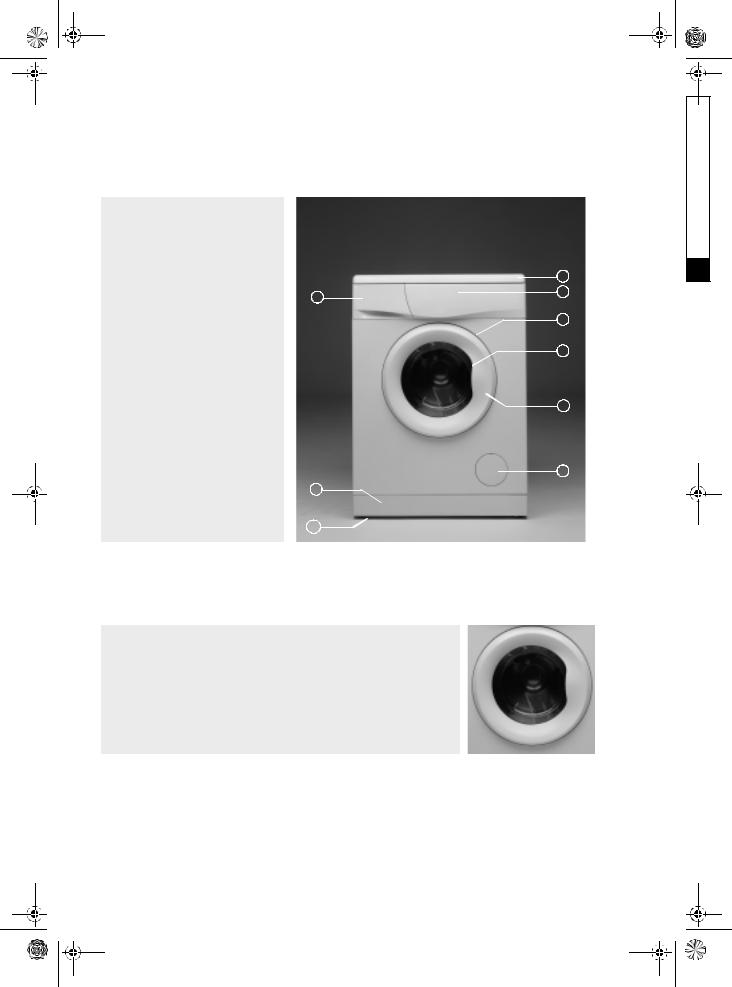
30110237GB.fm Page 22 Thursday, July 20, 2006 6:27 PM
DESCRIPTION OF THE WASHING MACHINE
1.Worktop
2.Control panel
3.Detergent dispenser
4.After-Service sticker (inside door)
5.Door
6. |
Child safety (inside door, if |
3 |
|
available)
7.Filter (inside compartment door)
8.Plinth
9.Adjustable feet
1
2
4
5
6
7
8
9
DOOR
To open the single glass door hold the door handle, press the inside handle and pull the door up. Close the door with light force, it will lock home audibly.
22
Black process 45.0° 100.0 LPI
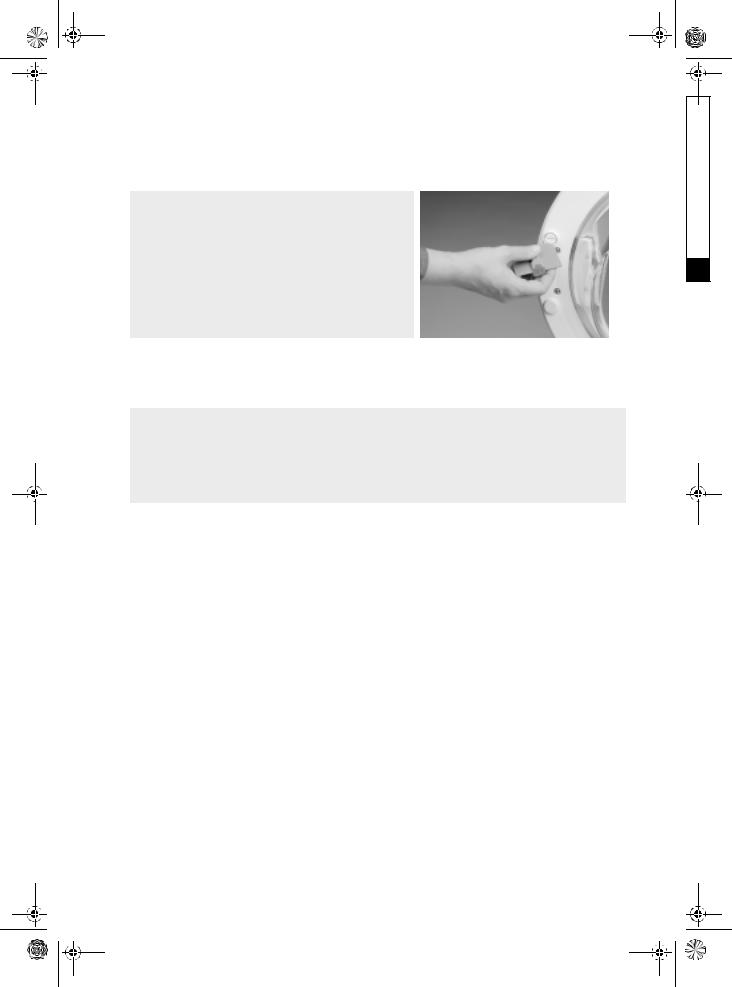
30110237GB.fm Page 23 Thursday, July 20, 2006 6:27 PM
CHILD SAFETY (IF AVAILABLE)
To secure the appliance against improper use turn the plastic screw on the interior of the door. To do this, use the thick rounded corner of the coloured insert from the detergent dispenser or a coin:
•Slot vertical: the door will not lock
•Slot horizontal: the door can be locked again
BEFORE THE FIRST WASH CYCLE
To remove any residual water used in testing by the manufacturer, we recommend that you carry out a short wash cycle without laundry.
1.Turn on the tap.
2.Close the door.
3.Pour a little detergent (about 30 ml) into the detergent compartment  .
.
4.Select and start a short programme (see quick reference guide).
PREPARING THE WASH
1.Sort the laundry according to...
•Type of fabric / care label symbol
Cottons, mixed fibres, easy care/synthetics, wool, handwashed items
•Colour
Separate coloured and white items. Wash new coloured articles separately
•Size
Laundry items of different sizes distribute themselves better in the drum and optimise the washing and spinning action
•Delicates
Wash small items (e.g. nylon stockings, belts etc.) and items with hooks (e.g. bras) in a washbag or pillow case with a zip fastener. Always remove curtain glides or wash curtains with the glides inside a cotton bag
2.Empty all pockets
Coins, safety pins etc. can damage the laundry, drum and tub.
3.Closures
Close zips and hooks and eyes; Tie loose belts or straps together.
Stain removal
•Blood, milk, eggs etc. are generally removed by the automatic enzyme phase of the programme
•To remove red wine, coffee, tea, grass and fruit stains etc. add a stain remover to the detergent dispenser  chamber
chamber
•Pre-treat heavily-soiled areas with stain remover if necessary
Dyeing
•Only use dyes that are suitable for washing machines
•Follow the manufacturer’s instructions.
•Plastic and rubber parts of the washing machine can be stained by dyes
Loading the laundry
1.Open the door.
2.Unfold the laundry and place it loosely in the drum. Observe the load sizes given in the Quick Reference Guide.
Note: overloading the machine will result in unsatisfactory washing results and creased laundry.
3.Close the door.
23
Black process 45.0° 100.0 LPI
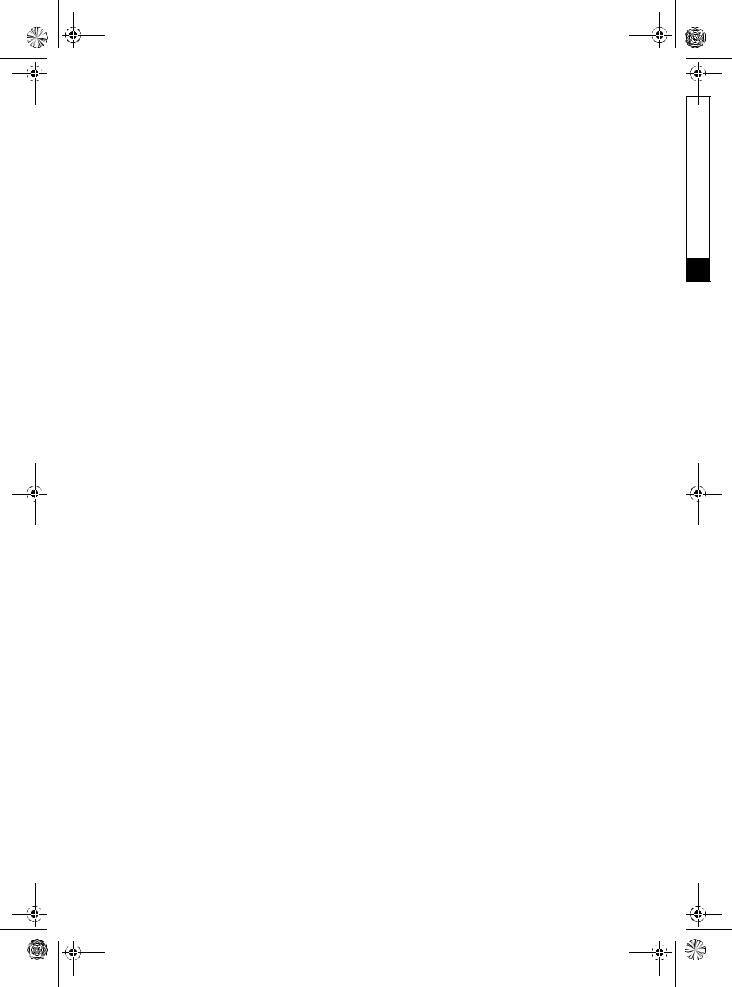
30110237GB.fm Page 24 Thursday, July 20, 2006 6:27 PM
DETERGENTS AND ADDITIVES
The choice of detergent depends on:
•type of fabric (cottons, easy care/synthetics, delicate items, wool).
Note: Use only specific detergents for washing wool
•colour
•the wash temperature
•degree and type of soiling
Remarks:
Whitish residues on dark fabrics are caused by insoluble compounds used in modern phosphatefree powder detergents. If this occurs, shake or brush out the fabric or use liquid detergents. Use only detergents and additives specifically produced for domestic washing machines.
When using descaling agents, dyes or bleaches for the pre-wash, make sure that they are suitable for use in domestic washing machines. Descaler could contain components which can attack parts of your washing machine
Do not use any solvents (e.g. turpentine, benzine). Do not wash fabrics in the machine which have been treated with solvents or flammable liquids.
Water hardness chart
Dosage
Follow the dosage recommendations on the detergent pack. They depend on:
•degree and type of soiling
•size of wash
full load follow the detergent manufacturer’s instructions;
half load: 3/4 the amount used for a full load; Minimum load (about 1 kg):
1/2 the amount used for a full load
•water hardness in your area (request information from the water company). Soft water requires less detergent than hard water (refer to water hardness table)
Notes:
Too much detergent can result in excess foam formation.
The cleaning effect deteriorates.
If the washing machine detects too much foam, it may prevent spinning.
Insufficient detergent may result in grey laundry in time and also calcifies the heating system, drum and hoses.
Water hardness |
Characteristics |
German |
French |
English |
|
°dH |
°fH |
°eH |
|||
|
|
||||
|
|
|
|
|
|
1 |
soft |
0-7 |
0-12 |
0-9 |
|
2 |
medium |
7-14 |
12-25 |
9-17 |
|
3 |
hard |
14-21 |
25-37 |
17-26 |
|
4 |
very hard |
over 21 |
over 37 |
over 26 |
|
|
|
|
|
|
24
Black process 45.0° 100.0 LPI
